Located in the Huangnan Tibetan Autonomous Prefecture of Qinghai Province, the Kanbula UNESCO Global Geopark sprawls across 3,149.34 square kilometers at the northeastern fringe of the Qinghai-Tibet Plateau, precisely within the transitional belt between China's first and second topographic terraces. This geopark boasts impeccably preserved stratigraphic structures from three pivotal geological epochs and bears witness to magmatic activities during the Indosinian and Yanshanian eras. The Triassic deep - marine sedimentary stratigraphic section of the Longwu River, with its distinct evolutionary sequence, has been globally acknowledged as a "geological textbook" for delving into the ocean-continent transition of the Paleo-Tethys Ocean. Here, the Longwu Gorge ultramafic rock mass, the awe-inspiring Danxia landforms, and the magnificent Yellow River scenery coexist in a rare harmony. It stands not only as an unrivaled venue for researching tectonic evolution and ocean-continent transformation but also vividly testifies to momentous geological shifts and serves as a natural laboratory for studying mega - landslides and climate change in the upper reaches of the Yellow River basin. Moreover, the geopark seamlessly blends the UNESCO-inscribed Intangible Cultural Heritage of Regong art with Qiang-Tibetan ethnic traditions, thus forging a coordinated "geology-ecology-culture" conservation paradigm. As a globally significant comprehensive geopark, it uniquely fuses high-precision geoscientific research, rich multicultural experiences, and the protection of the plateau ecosystem. This translation adheres strictly to UNESCO's nomenclature, employing "UNESCO Global Geopark" for official recognition and "UNESCO Intangible Cultural Heritage" for cultural aspects. Technical terms are accurately rendered to guarantee scientific precision.

Situated in the southern part of Yunyang County, Chongqing Municipality, the Yunyang UNESCO Global Geopark occupies a core area of 1,124.05 square kilometers within the Three Gorges Reservoir region along the Yangtze River. Renowned worldwide, this geopark is celebrated for its Middle Jurassic dinosaur fossil assemblages, prominently featuring an 18.2 - kilometer-long "Dinosaur Fossil Wall" and the planet's largest single - layer Jurassic dinosaur fossil cluster. These remarkable findings bridge the evolutionary trajectory of Asian Jurassic dinosaurs, filling a crucial void in global dinosaur research. The park also encompasses the Longgang Tiankeng karst landforms, harbors rare species like the large Indian civet (Viverra zibetha) and small Indian civet (Viverricula indica), and serves as the habitat of the newly discovered Yunyang paddle - tailed toad (Leptobrachella yunyangensis). By integrating historical landmarks such as Zhang Fei Temple and Panshi City with Tujia ethnic culture, it has fashioned a distinctive conservation system that interconnects dinosaur evolution, karst landscapes, ecology, and cultural heritage, vividly spotlighting the harmonious coexistence of geological processes and human civilization.
